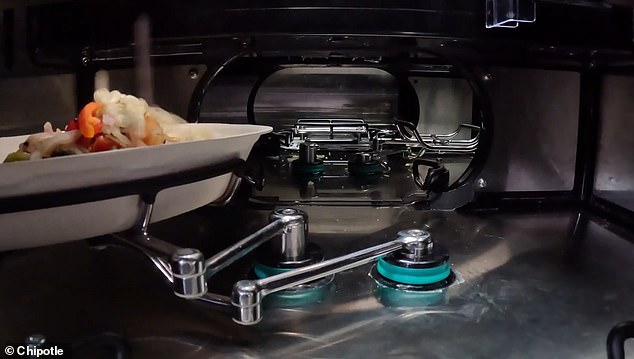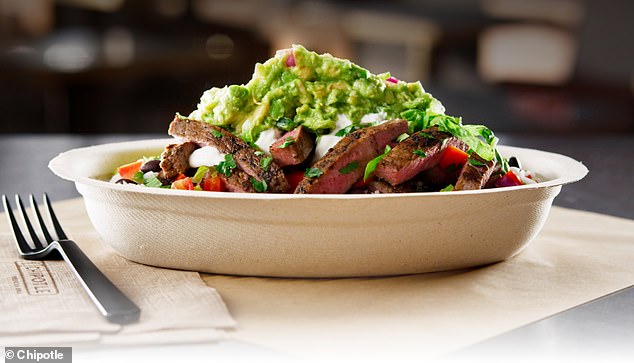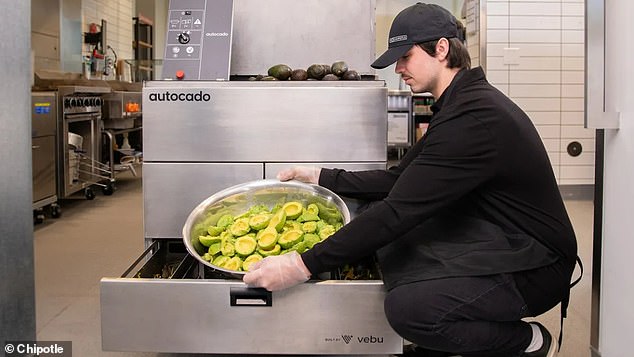Chipotle has unveiled two robots that can perform tasks normally performed by its employees.
The ‘autocado’ can peel, pit and slice an avocado for guacamole in 26 seconds. Meanwhile, a ‘digital prep line’ serves up portions of salads and dishes based on orders on the app.
The machines are part of an automation drive that Chipotle bosses hope will reduce the number of workers needed, thereby lowering rising labor costs.
It’s no surprise, then, that they’re being used first at two of the Mexican chain’s restaurants in California, the company announced Monday.
Recent legislation raised the minimum wage for fast food workers to $20 an hour in the state.
Chipotle’s avocado processing robot has moved from testing to restaurants
The controversial pay increase – $4 more than the state’s minimum wage for any other job – was introduced by California Governor Gavin Newsom at chains with more than 60 locations across the United States and took effect on April 1.
Chains like Burger King have already accelerated the implementation of digital ordering kiosks to reduce the number of cashiers needed at California restaurants.
It’s not yet clear how the production costs of using Chipotle’s new machines compare to the human labor required to produce Chipotle’s menu items.
It is still unclear how many items the digital assembly line can produce per hour compared to manpower.
However, Chipotle argued that using the machines was not just a matter of “efficiency,” but also of the consistency of its menu items.
In July, the company — which has nearly 3,400 locations in the United States — admitted that widespread customer complaints about varying portion sizes across stores were valid.
Since two out of every three orders the chain makes are for salads and bowls, executives believe the digital production line could free up a considerable amount of staff time.
Questions had already been raised about the safety of the digital manufacturing line while it was in the testing phase.
A promotional video released last year showed chopped ingredients bouncing from bowls into the machine, which some questioned as a potential hazard.
“Our operations and food safety teams have worked closely with our technology teams to ensure the design takes into account aspects such as cleanliness, speed and accuracy,” CEO Brian Niccol said on an earnings call in July.
‘There are a lot of things that happen at home to make us more effective at cooking and preparation, which then sets us up to be consistently successful.’

The product line has also been introduced in two California restaurants.

Machines will boost efficiency and ‘consistency’ in meal sizes, says Chipotle
The Mexican chain said feedback from staff and customers will determine whether it continues to roll out the new machines to more restaurants.
Chipotle has bet big on technological advancements, investing $100 million in its Cultivate Next fund.
The fund gives money to partner companies to develop machinery that can hopefully one day be used on a large scale in their restaurants or in their supply chain.
Chipotle’s sales this year have exceeded Wall Street expectations, boosted by price increases and a jump in the number of loyal customers.
But the company has come under fire for its alleged variations in portion sizes.
This prompted Chipotle’s then-CEO Brian Nicol – who has now moved to Starbucks – denied giving instructions Staff will skimp on rations The company revealed that it will be implementing changes to ensure customer satisfaction.
He revealed that Chipotle will retrain its staff to ensure that “generous portions” are consistent across its more than 3,500 stores.
Last month, Wells Fargo analyst Zachary Fadem and his team put the theory that Chipotle has been skimping on its typically large portions to the test, after a series of videos posted on TikTok showed employees barely filling their burrito bowls.
The team ordered and weighed 75 bowls, all with the same ingredients, from eight locations in New York City.
They found that the consistency of burrito bowls varied widely from restaurant to restaurant, with some locations serving bowls that were up to 33 percent heavier than others, the study found.


